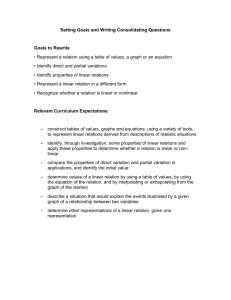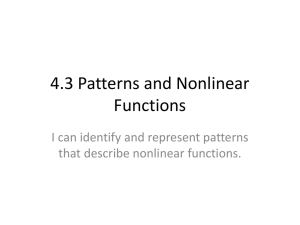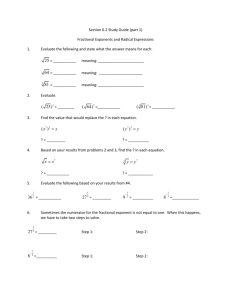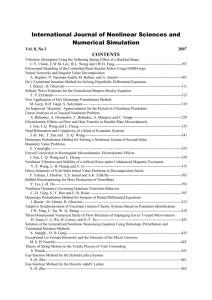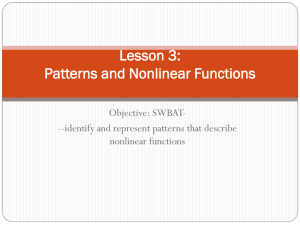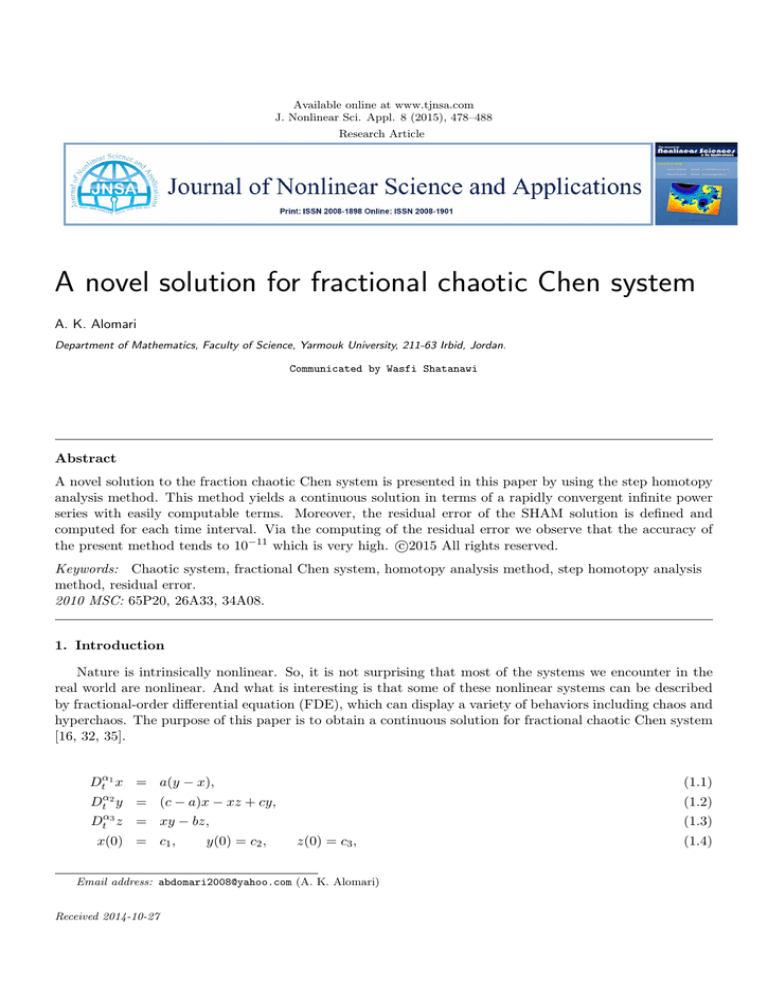
Available online at www.tjnsa.com
J. Nonlinear Sci. Appl. 8 (2015), 478–488
Research Article
A novel solution for fractional chaotic Chen system
A. K. Alomari
Department of Mathematics, Faculty of Science, Yarmouk University, 211-63 Irbid, Jordan.
Communicated by Wasfi Shatanawi
Abstract
A novel solution to the fraction chaotic Chen system is presented in this paper by using the step homotopy
analysis method. This method yields a continuous solution in terms of a rapidly convergent infinite power
series with easily computable terms. Moreover, the residual error of the SHAM solution is defined and
computed for each time interval. Via the computing of the residual error we observe that the accuracy of
c
the present method tends to 10−11 which is very high. ⃝2015
All rights reserved.
Keywords: Chaotic system, fractional Chen system, homotopy analysis method, step homotopy analysis
method, residual error.
2010 MSC: 65P20, 26A33, 34A08.
1. Introduction
Nature is intrinsically nonlinear. So, it is not surprising that most of the systems we encounter in the
real world are nonlinear. And what is interesting is that some of these nonlinear systems can be described
by fractional-order differential equation (FDE), which can display a variety of behaviors including chaos and
hyperchaos. The purpose of this paper is to obtain a continuous solution for fractional chaotic Chen system
[16, 32, 35].
Dtα1 x = a(y − x),
(1.1)
Dtα2 y
Dtα3 z
= (c − a)x − xz + cy,
(1.2)
= xy − bz,
(1.3)
x(0) = c1 ,
y(0) = c2 ,
z(0) = c3 ,
Email address: abdomari2008@yahoo.com (A. K. Alomari)
Received 2014-10-27
(1.4)
A. K. Alomari, J. Nonlinear Sci. Appl. 8 (2015), 478–488
479
where Dαi , i = 1, 2, 3 are Caputo fractional derivatives, a, b, c from R and 0 < αi ≤ 1.
Finding accurate solution for FDEs has been an active research undertaking [20, 27, 30, 31, 33]. Exact
solutions of most of the FDEs cannot be found easily, thus analytical and numerical methods must be used.
For example, generalized Adams-Bashforth-Moulton method (GABMM) is one of the most used method to
solve fractional differential equations [9, 10, 16, 34]. Some of the recent analytic methods for solving nonlinear
problems include the Adomian decomposition method (ADM) [12, 15, 29], homotopy-perturbation method
(HPM) [21, 24] and variational iteration method (VIM) [22, 25].
Recently, homotopy analysis method (HAM) becomes one of the most famous technique to solve such
nonlinear problems. the method was proposed by Liao [17, 18]. Many researchers have applied this method
for different class of differential equations [1, 2, 3, 6, 7, 11, 13, 14, 19, 28]. Alomari et al. [4] used the idea
of time step in the algorithm of HAM to get multistage homotopy analysis method (MSHAM) and apply
to Chen system. Recently, Alomari et al. [5] introduce new algorithm to obtain the solution of fractional
chaotic system using HAM.
This paper investigates for the first time the applicability and effectiveness of HAM when we hybrid
the numerical with analytical in a sequence of intervals (i.e. time step) for finding accurate approximate
solutions to the fractional Chen system. To the best of our knowledge, this is also the first time that the
residual error can be calculated for the analytical solution at each subinterval of fractional Chen system.
Numerical results are presented graphically and are found to be in excellent agreement with the GABMM
solution.
2. Preliminaries and notations
In this section, we give some definitions and properties of the fractional calculus and homotopy-derivative
2.1. Fractional calculus
The following properties can found in [26].
Definition 2.1. A real function f (t), t > 0, is said to be in the space Cµ , µ ∈ R, if there exists a real
number p > µ, such that f (t) = tp f1 (t), where f1 (t) ∈ C(0, ∞), and it is said to be in the space Cµn if and
only if h(n) ∈ Cµ , n ∈ N .
Definition 2.2. The Riemann-Liouville fractional integral operator (J α ) of order α ≥ 0, of a function
f ∈ Cµ , µ ≥ −1, is defined as
J α f (t) =
1
Γ(α)
∫t
(t − s)α−1 f (t)s.
(α > 0),
(2.1)
0
J 0 f (t) = f (t),
where Γ(α) is the well-known gamma function.
Some of the properties of the operator J α , which we will need here, are as follows:
For f ∈ Cµ , µ ≥ −1, α, β ≥ 0 and γ ≥ −1:
1. J α J β f (t) = J α+β f (t),
2. J α J β f (t) = J β J α f (t),
3. J α tγ =
Γ(γ+1) α+γ
.
Γ(α+γ+1) t
(2.2)
A. K. Alomari, J. Nonlinear Sci. Appl. 8 (2015), 478–488
480
Definition 2.3. The fractional derivative (Dα ) of f (t), in the Caputo sense is defined as
1
Γ(n − α)
α
D f (t) =
∫t
(t − s)n−α−1 f (n) (t)s.,
(2.3)
0
n .
for n − 1 < α < n, n ∈ N, t > 0, f ∈ C−1
The following are two basic properties of the Caputo fractional derivative:
n , n ∈ N, then D α f, 0 ≤ α ≤ n is well defined and D α f ∈ C .
1. Let f ∈ C−1
−1
n
2. Let n − 1 ≤ α ≤ n, n ∈ N and f ∈ Cµ , µ ≥ −1. Then
(J α Dα )f (t) = f (t) −
n−1
∑
f (k) (0+ )
k=0
tk
.
k!
(2.4)
2.2. homotopy-derivative
The following properties can found in [19]
Definition 2.4. Let ϕ be a function of the homotopy-parameter q, then
1 ∂ m ϕ Dm (ϕ) =
.
m! ∂q m q=0
(2.5)
is called the mth-order homotopy-derivative of ϕ, where m ≥ 0 is an integer.
For homotopy-series the below
ϕ1 =
+∞
∑
i
ui q ,
ϕ2 =
i=0
+∞
∑
vi q i
i=0
hold and
1. Dm (ϕ1 ) = um .
2. Dm (qϕ1 ) = Dm−1 (ϕ1 )
3. If L be a linear operator independent of the homotopy-parameter q. For homotopy-series, then
Dm (Lϕ1 ) = LDm (ϕ1 ).
4. If f and g be functions independent of the homotopy-parameter q, then
Dm (f ϕ1 ± gϕ2 ) = f Dm (ϕ1 ) ± gDm (ϕ2 ).
5. Dm (ϕ1 ϕ2 ) =
∑m
i=0 ϕ1,i ϕ2,m−i
3. Solution approaches
To solve (1.1)–(1.3), we choose the base function as
{tnα1 +mα2 +kα3 |n ≥ 0, m ≥ 0, k ≥ 0},
(3.1)
A. K. Alomari, J. Nonlinear Sci. Appl. 8 (2015), 478–488
481
so the solutions are in the form
x(t) = a0,0,0 +
y(t) = b0,0,0 +
+∞ ∑
+∞ ∑
+∞
∑
an,m,k tnα1 +mα2 +kα3 ,
(3.2)
bn,m,k tnα1 +mα2 +kα3 ,
(3.3)
cn,m,k tnα1 +mα2 +kα3 ,
(3.4)
n=0 m=0 k=0
+∞ ∑
+∞ ∑
+∞
∑
z(t) = c0,0,0 +
n=0 m=0 k=0
+∞ ∑
+∞ ∑
+∞
∑
n=0 m=0 k=0
where an,m,k , bn,m,k and cn,m,k are the coefficients. It is straightforward to choose
x0 (t) = c1 ,
y0 (t) = c2 ,
z0 (t) = c3 ,
(3.5)
as our initial approximations of x(t), y(t) and z(t), and the linear operator should be
Lα1 [x̂] = Dα1 x̂,
(3.6)
α2
(3.7)
α3
(3.8)
Lα2 [ŷ] = D ŷ,
Lα3 [ẑ] = D ẑ,
since we used Caputo fractional derivative then we have the property
Lα1 [A1 ] = Lα2 [A2 ] = Lα3 [A3 ] = 0,
(3.9)
where Ai i = 1, 2, 3 are the integration constants that will be determined by the initial conditions.
If q ∈ [0, 1] and ~ indicate the embedding and non-zero auxiliary parameters, respectively, then the
zeroth-order deformation problems are of the following form:
(1 − q)Lα1 [x̂(t; q) − x0 (t)] = q~Nx [x̂(t; q), ŷ(t; q)],
(3.10)
(1 − q)Lα2 [ŷ(t; q) − y0 (t)] = q~Ny [x̂(t; q), ŷ(t; q), ẑ(t; q)],
(3.11)
(1 − q)Lα3 [ẑ(t; q) − z0 (t)] = q~Nz [x̂(t; q), ŷ(t; q), ẑ(t; q)],
(3.12)
subject to the initial conditions
x̂(0; q) = c1 ,
ŷ(0; q) = c2 ,
ẑ(0; q) = c3 ,
(3.13)
in which we define the nonlinear operators Nx , Ny and Nz as
Nx [x̂(t; q), ŷ(t; q)] =
Ny [x̂(t; q), ŷ(t; q), ẑ(t; q)] =
Nz [x̂(t; q), ŷ(t; q), ẑ(t; q)] =
∂ α1 x̂(t; q)
− a(ŷ(t; q) − x̂(t; q)),
∂tα1
∂ α2 ŷ(t; q)
− (c − a)x̂(t; q) + x̂(t; q)ẑ(t; q) − cŷ(t; q),
∂tα2
∂ α3 ẑ(t; q)
− x̂(t; q)ŷ(t; q) + bẑ(t; q).
∂tα3
For q = 0 and q = 1, the above zeroth-order equations (3.10)-(3.12) have the solutions
x̂(t; 0) = x0 (t),
ŷ(t; 0) = y0 (t),
ẑ(t; 0) = z0 (t),
(3.14)
x̂(t; 1) = x(t),
ŷ(t; 1) = y(t),
ẑ(t; 1) = z(t).
(3.15)
and
A. K. Alomari, J. Nonlinear Sci. Appl. 8 (2015), 478–488
482
When q increases from 0 to 1, then x̂(t; q), ŷ(t; q) and ẑ(t; q) vary from x0 (t), y0 (t) and z0 (t) to x(t), y(t) and
z(t), respectively. Expanding x̂, ŷ and ẑ in Taylor series with respect to q, we have
x̂(t; q) = x0 (t) +
ŷ(t; q) = y0 (t) +
ẑ(t; q) = z0 (t) +
∞
∑
m=1
∞
∑
m=1
∞
∑
xm (t)q m ,
(3.16)
ym (t)q m ,
(3.17)
zm (t)q m ,
(3.18)
m=1
in which
xm (t) = Dm (x̂(t; q)),
ym (t) = Dm (ŷ(t; q)),
zm (t) = Dm (ẑ(t; q)),
(3.19)
where ~ is chosen in such a way that these series are convergent at q = 1. Therefore, through Eqs. (3.14)–
(3.19), we have
x(t) = x0 (t) +
y(t) = y0 (t) +
z(t) = z0 (t) +
∞
∑
m=1
∞
∑
m=1
∞
∑
xm (t),
(3.20)
ym (t),
(3.21)
zm (t).
(3.22)
m=1
Take the mth-order homotopy-derivative of zeroth-order equations (3.10)-(3.12) and used the properties
(1)–(4), then we have the mth-order deformation equations
x
Lα1 [xm (t) − χm xm−1 (t)] = ~Rm
(t),
(3.23)
y
Lα2 [ym (t) − χm ym−1 (t)] = ~Rm
(t),
(3.24)
z
Lα3 [zm (t) − χm zm−1 (t)] = ~Rm
(t),
(3.25)
with the following initial conditions:
xm (0) = 0,
ym (0) = 0,
zm (0) = 0,
(3.26)
x (t), Ry (t) and Rz (t) can be found by used the properties (1),(4) and (5) as
where Rm
m
m
x
Rm
(t) = Dtα1 xm−1 − a(ym−1 − xm−1 ),
y
Rm
(t) = Dtα2 ym−1 − (c − a)xm−1 +
m−1
∑
(3.27)
xi (t)zm−1−i (t) − cym−1 (t),
(3.28)
i=0
z
Rm
(t) = Dtα3 zm−1 −
m−1
∑
i=0
and
{
χm =
0,
1,
m ≤ 1,
m > 1.
xi (t)ym−1−i (t) + bzm−1 (t).
(3.29)
A. K. Alomari, J. Nonlinear Sci. Appl. 8 (2015), 478–488
483
In this way, it is easy to solve the linear non-homogeneous Eqs. (3.23)–(3.25) at initial conditions (3.26)
for all m ≥ 1, and now we successfully obtain
~tα1 a (−c2 + c1 )
,
Γ (α1 + 1)
~tα2 (−c1 c + c1 a − cc2 + c3 c1 )
,
Γ (α2 + 1)
~tα3 c2 (b − c1 )
,
Γ (α3 + 1)
x1 (t) =
y1 (t) =
z1 (t) =
etc. Then the 13-term of the approximate solutions of Eqs. (1.1)–(1.4) are
x(t) = x0 (t) +
y(t) = y0 (t) +
z(t) = z0 (t) +
12
∑
m=1
12
∑
m=1
12
∑
xm (t),
(3.30)
ym (t),
(3.31)
zm (t).
(3.32)
m=1
To determine the value of ~ we plot the ~-curves for Eqs. (3.30)–(3.32) in Fig. (1).
1641.7
2064
-655.1
1641.65
-655.3
1641.5
1641.45
2063.6
z(10−7 )
1641.55
y(10−7 )
x(10−7 )
-655.2
2063.8
1641.6
2063.4
-655.4
-655.5
1641.4
2063.2
-655.6
1641.35
1641.3
-655.7
2063
-0.6
-0.8
-1
-1.2
-1.4
-0.6
-0.8
h̄
-1
-1.2
-1.4
h̄
-0.6
-0.8
-1
-1.2
-1.4
h̄
Figure 1: ~-curves of 13th-order approximation for (0.9,0.9,0.9)
From this figure, it is noted that the valid regions of ~ correspond to the line segments nearly parallel to
the horizontal axis.
If ~ = −1 we get the homotopy perturbation method (HPM) solution when α1 = α2 = α3 = 1 which is
not effective for large values of t (for more detail see [8]).
3.1. SHAM
The HAM solution for Eqs. (3.30)–(3.32) is not effective for larger t. In case if we need the solution for [0, 7], then the simple idea is to divide the interval [0, 7] to subintervals with time step ∆t
and we get the solution at each subinterval. So in this case we have to satisfy the initial condition at
each of the subinterval. Accordingly, the initial values x0 , y0 , z0 will be changed for each subinterval, i.e.
x(t∗ ) = c∗1 = x0 , y(t∗ ) = c∗2 = y0 and z(t∗ ) = c∗3 = z0 and we should satisfy the initial conditions xm (t∗ ) = 0,
ym (t∗ ) = 0 and zm (t∗ ) = 0 for all m ≥ 1 so
x1 (t) =
~(t − t∗ )α1 a (−c2 + c1 )
,
Γ (α1 + 1)
y1 (t) =
~(t − t∗ )α2 (−c1 c + c1 a − cc2 + c3 c1 )
,
Γ (α2 + 1)
A. K. Alomari, J. Nonlinear Sci. Appl. 8 (2015), 478–488
484
~(t − t∗ )α3 c2 (b − c1 )
,
Γ (α3 + 1)
z1 (t) =
..
.
So, the solution will be as follows:
12
∑
x(t) = c∗1 +
xm (t − t∗ ),
(3.33)
ym (t − t∗ ),
(3.34)
zm (t − t∗ ),
(3.35)
m=1
y(t) =
c∗2
+
12
∑
m=1
z(t) =
c∗3
+
12
∑
m=1
where t∗ starting from t0 = 0 until tn = T = 7. To carry out the solution on every subinterval of equal
length ∆t, we need to know the values of the following initial conditions:
c1 = x(t∗ ),
c2 = y(t∗ ),
c3 = z(t∗ ).
In general, we do not have these information at our clearance except at the initial point t∗ = t0 = 0, but we
can obtain these values by assuming that the new initial condition is the solution in the previous interval.
(i.e. If we need the solution in interval [ti , ti+1 ], then the initial conditions of this interval will be as
c1 = x(ti ) =
c2 = y(ti ) =
c3 = z(ti ) =
12
∑
m=0
12
∑
m=0
12
∑
xm (ti − ti−1 ),
(3.36)
ym (ti − ti−1 ),
(3.37)
zm (ti − ti−1 ),
(3.38)
m=0
where c1 , c2 and c3 are the initial conditions in the interval [ti , ti+1 ]). By this way we get modified homotopy
perturbation method (MHPM) solution as a special case when ~ = −1 and α1 = α2 = α3 = 1 [8].
3.2. Error analysis for SHAM
The different between the exact solution and the given solution which we will so-call residual error can
be define as
Ex = Dtα1 X − a(Y − X),
Ey =
Ez =
Dtα2 Y
Dtα3 Z
(3.39)
− (c − a)X + XZ − cY,
(3.40)
− XY + bZ.
(3.41)
where X, Y and Z are the HAM solution for the equations (1.1)–(1.3) respectively. Since the SHAM solution
is analytic at each time step then it is easy to obtain the residual error at each time step. According Eqs.
(3.39)–(3.41), we can find the residual error on each time step by applying the that equations and using
c1 , c2 and c3 which is defined as in SHAM solution. We noted that the orders of magnitude of the errors in
SHAM solution depend on the order of approximation and the length of the subintervals.
A. K. Alomari, J. Nonlinear Sci. Appl. 8 (2015), 478–488
30
10-term
12-term
15
20
15
10
5
10
x(t)
y(t)
10
10-term
12-term
25
20
20
x(t)
30
30
10-term
12-term
25
485
0
5
0
0
-10
-5
-10
-5
-10
-20
-15
-15
-20
-20
-30
0
1
2
3
4
5
6
7
0
1
2
3
t
4
5
6
7
0
1
2
3
t
4
5
6
7
t
Figure 2: Time series of the SHAM solution Using 10 and 12 order of approximation for (0.95,0.95,0.95)
4. Results and discussion
In this part, we set a = 35, c = 28, b = 3 and we take the initial conditions x(0) = −10, y(0) = 0 and
z(0) = 37 as in [4] after the standard case (α1 , α2 , α3 ) as (1, 1, 1). To observe the convergent of the solution,
we plot the 10-term and 12-term of SHAM solution with ∆t = 0.005 in Fig. 2. It is clear that the solution
of 10-term like the solution of 12-term then we can consider 12-term as good approximate solution. The
phase portraits of the SHAM solution and GABMM solution are given in Fig. 3 and Fig. 4 at different
fractional derivative. The figure gives that SHAM solution have good agreement with GABMM solution.
z
z
45
40
35
30
25
20
15
10
5
45
40
35
30
25
20
15
10
5
-30
-20
(a)
-10
y
0
10
20
30
2025
1015
0 5
x
-5
-15-10
-25-20
-30
-20
(b)
-10
y
0
10
20
30
2025
1015
0 5
x
-5
-15-10
-25-20
Figure 3: Comparison the phase portraits of x − y − z using 12-term SHAM in (b) with GABMM in (a) when (α1 , α2 , α3 ) as
(0.95,0.95,0.95)
z
z
40
35
30
25
20
15
10
5
-25 -20 -15
(a)
40
35
30
25
20
15
10
-10 -5
y
0
-10
5 10
-15
15 20
25 -20
-5
0
5
10
15
20
-25 -20 -15
x
(b)
-10 -5
y
0
5 10
15 20
25
2025
1015
0 5
x
-5
-15-10
-25-20
Figure 4: Comparison the phase portraits of x − y − z using 12-term SHAM in (b) with GABMM in (a) when (α1 , α2 , α3 ) as
(0.9,0.9,0.9)
The residual error of the SHAM solution is presented in Fig.5 and 6 for
(0.95, 0.95, 0.95)
and
(0.99, 0.99, 0.99)
respectively. Table (1) and (2) give the residual error for the given solution at several points. We observe
that a higher accuracy of the given solution is cited which is not extended than 10−10 . On the other hand
the GABMM usually used accuracy with 10−6 .
A. K. Alomari, J. Nonlinear Sci. Appl. 8 (2015), 478–488
486
4. ´ 10-11
1.5 ´ 10-10
1.5 ´ 10-10
-11
1. ´ 10-10
1. ´ 10-10
-11
5. ´ 10-11
2. ´ 10
Ez
Ey
Ex
5. ´ 10
0
0
0
-2. ´ 10-11
-5. ´ 10-11
-5. ´ 10-11
-4. ´ 10-11
-1. ´ 10-10
-1. ´ 10-10
0
1
2
3
(a)
4
5
6
7
0
1
2
3
(b)
t
4
5
6
7
0
1
2
3
(c)
t
4
5
6
7
t
Figure 5: Residual error for SHAM solution using 8-terms with △t = 0.001 when (α1 , α2 , α3 ) as (0.95,0.95,0.95)
2. ´ 10-12
5. ´ 10-12
5. ´ 10-12
0
Ez
Ez
Ez
1. ´ 10-12
0
0
-1. ´ 10-12
-5. ´ 10-12
-5. ´ 10-12
-2. ´ 10-12
0
1
(a)
2
3
4
5
6
7
0
(b)
t
1
2
3
4
t
5
6
7
0
1
2
3
(c)
4
5
6
7
t
Figure 6: Residual error for SHAM solution using 8-terms with △t = 0.001 when (α1 , α2 , α3 ) as (0.99,0.99,0.99)
Table 1: The Residual error for αi = 0.95 with 8-terms and ∆t = 0.001 using 20 Digit
t
1
2
3
4
5
6
7
Ex
5.68434E-14
1.13687E-13
-7.10543E-15
0
-8.52651E-14
-8.52651E-14
-7.10543E-15
Ey
-7.81597E-14
-1.27898E-13
0
5.68434E-14
0
-2.84217E-14
-5.68434E-14
Ez
-2.84217E-14
-1.56319E-13
-1.42109E-14
-3.55271E-15
-3.01981E-14
-6.12843E-14
-7.10543E-15
Table 2: The Residual error for αi = 0.99 with 8-terms and ∆t = 0.001 using 20 Digit
t
1
2
3
4
5
6
7
Ex
-2.27374E-13
-8.9706E-14
2.84217E-14
-2.8777E-13
0
-1.42109E-14
8.52651E-14
Ey
-5.68434E-14
-1.06581E-13
1.42109E-13
-4.05009E-13
-5.68434E-14
-2.84217E-14
3.97904E-13
Ez
3.97904E-13
-7.10543E-14
1.42109E-14
-5.40012E-13
0
1.42109E-14
6.53699E-13
5. Conclusions
In this present work continuous solution for fractional Chen system is obtained by SHAM. The modified
method has the advantage of giving an analytical form of the solution within each time interval which is
not possible in purely numerical techniques like fourth–order Runge–Kutta method RK4 or ABMM. The
residual error for subintervals solution is defined and calculated. We also note that the SHAM solutions
A. K. Alomari, J. Nonlinear Sci. Appl. 8 (2015), 478–488
487
were computed via a simple algorithm without any need for perturbation techniques, special transformations,
linearization or discretization. The SHAM solutions are in excellent agreement with the GABMM solution.
Moreover The HPM and MHPM solution is a special case when ~ = −1 and α1 = α2 = α3 = 1.
Acknowledgements
The author would like to thank the editor and reviewers for their valuable comments and suggestions to
improve the paper. Also, we thank the research council at Yarmouk university for their financial support.
References
[1] S. Abbasbandy, The application of homotopy analysis method to solve a generalized Hirota-Satsuma coupled KdV
equation, Phys. Lett. A, 361 (2007), 478–483. 1
[2] A. K. Alomari, M. S. M. Noorani, R. Nazar, On the homotopy analysis method for the exact solutions of Helmholtz
equation, Chaos Solitons Fractal, 41 (2009), 1873–1879. 1
[3] A. K. Alomari, F. Awawdeh, N. Tahat, F. Bani Ahmad, Shatanawi W, Multiple solutions for fractional differential
equations: Analytic approach, Appl. Math. Comput., 219 (2013), 8893–8903. 1
[4] A. K. Alomari, M. S. N. Noorani, R. Nazar, Adaptation of homotopy analysis method for the numeric-analytic
solution of Chen system, Comm. Nonlinear Sci. Numer. Simul., 14 (2009), 2336–2346. 1, 4
[5] A. K. Alomari, M. S. N. Noorani, R. Nazar, C. P. Li, Homotopy analysis method for solving fractional Lorenz
system, Comm. Nonlinear Sci. Numer. Simul., 15 (2010), 1864–1872. 1
[6] M. A. F. Araghi, A. Fallahzadeh, Discrete Homotopy Analysis Method for Solving Linear Fuzzy Differential
Equations, Adv. Environ. Biol., 9 (2015), 195–201. 1
[7] A. S. Bataineh, M. S. N. Noorani, I. Hashim, Solving systems of ODEs by homotopy analysis method, Comm.
Nonlinear Sci. Numer. Simul., 13 (2008), 2060–2070. 1
[8] M. S. H. Chowdhury, I. Hashim, Application of multistage homotopy-perturbation method for the solutions of the
Chen system, Nonlinear Anal. Real. World Appl., 10 (2009), 381–391. 3, 3.1
[9] K. Diethelm, N. J. Ford, Analysis of fractional differential equations, J. Math. Anal. Appl., 265 (2002), 229–248.
1
[10] K. Diethelm, N. J. Ford, A. D. Freed, A predictor-corrector approach for the numerical solution of fractional
differential equations, Nonlinear Dyn., 29 (2002), 3–22. 1
[11] A. Fallahzadeh, K. Shakibi, A method to solve Convection-Diffusion equation based on homotopy analysis method,
J. Interpolat. Approx. Sci. Comput., 2015 (2015), 8 pages. 1
[12] A. Golbabai, K. Sayevand, An efficient applications of hes variational iteration method based on a reliable modification of Adomian algorithm for nonlinear boundary value problems, J. Nonlinear Sci. Appl., 3 (2010), 152 –
156. 1
[13] T. Hayat, M. Sajid, On analytic solution for thin film flow of a fourth grade fluid down a vertical cylinder, Phys.
Lett. A, 361 (2007), 316–322. 1
[14] T. Hayat, M. Khan, Homotopy solutions for a generalized second-grade fluid past a porous plate, Nonlinear Dyn.,
42 (2005), 395–405. 1
[15] H. Jafari, V. Daftardar-Gejji, Solving a system of nonlinear fractional differential equations using Adomian decomposition, J. Comput. Appl. Math., 196 (2006), 644–651. 1
[16] C. Li C, G. Peng, Chaos in Chen’s system with a fractional order, Chaos Solitons Fractals, 22 (2004), 443–450.
1, 1
[17] S. Liao, The proposed homotopy analysis techniques for the solution of nonlinear problems, Ph.D. Dissertation.
Shanghai Jiao Tong University, Shanghai (in English), (1992). 1
[18] S. Liao, Beyond perturbation: Introduction to the homotopy analysis method. CRC Press, Chapman and Hall,
Boca Raton, (2003). 1
[19] S. Liao, Notes on the homotopy analysis method: Some definitions and theorems, Commun. Nonlinear Sci. Numer.
Simul., 14 (2009), 983–997. 1, 2.2
[20] Y. Liu Y, H. Shi, Existence of unbounded positive solutions for BVPs of singular fractional differential equations,
J. Nonlinear Sci. Appl., 5 (2012), 281–293. 1
[21] S. Momani, Z. Odibat, Homotopy perturbation method for nonlinear partial differential equations of fractional
order, Phys. Lett. A., 365 (2007), 345–350. 1
[22] S. Momani, Z. Odibat, Numerical comparison of methods for solving linear differential equations of fractional
order, Chaos Solitons Fractals, 31 (2007), 1248–1255. 1
[23] M. Inc, On exact solution of Laplace equation with Dirichlet and Neumann boundary conditions by the homotopy
analysis method, Phys. Lett. A., 365 (2007), 412–415.
[24] Z. Odibat, S. Momani, Modified homotopy perturbation method: application to quadratic Riccati differential
equation of fractional order, Chaos Solitons Fractals, 36 (2008), 167–174. 1
A. K. Alomari, J. Nonlinear Sci. Appl. 8 (2015), 478–488
488
[25] Z. Odibat, S. Momani, Application of variational iteration method to nonlinear differential equation of fractional
order, Int. J. Nonlinear Sci. Numer. Simul., 7 (2006), 27–34. 1
[26] I. Podlubny, Fractional differential equations, Academic Press, New York, (1999). 2.1
[27] T. Qiu, Z. Bai, Positive solutions for boundary value problem of nonlinear fractional differential equation, J.
Nonlinear Sci. Appl., 1 (2008), 123–131. 1
[28] M. Sajid, T. Javed, T. Hayat, MHD rotating flow of a viscous fluid over a shrinking surface, Nonlinear Dyn., 51
(2008), 259–265. 1
[29] N. T. Shawagfeh, Analytical approximate solutions for nonlinear fractional differential equations, Appl. Math.
Comput., 131 (2002), 517–529. 1
[30] T. Wang, F. Xie, Existence and uniqueness of fractional differential equations with integral boundary conditions,
J. Nonlinear Sci. Appl., 1 (2008), 206–212. 1
[31] Y. Wang, Y. Yang, Positive solutions for Caputo fractional differential equations involving integral boundary
conditions, J. Nonlinear Sci. Appl., 8 (2015), 99–109. 1
[32] J. Wanga, X. Xionga, Y. Zhang, Extending synchronization scheme to chaotic fractional-order Chen systems,
Physica A, 370 (2006), 279–285. 1
[33] W. Yang, Positive solutions for singular coupled integral boundary value problems of nonlinear Hadamard fractional differential equations, J. Nonlinear Sci. Appl., 8 (2015), 110–129. 1
[34] T. S. Zhou, C. Li, Synchronization in fractional-order differential systems, Phys. D., 212 (2005), 111–125. 1
[35] H. Zhu, S. Zhou, Z. He, Chaos synchronization of the fractional-order Chen’s system, Chaos Solitons Fractals, 41
(2009), 2733–2740. 1


